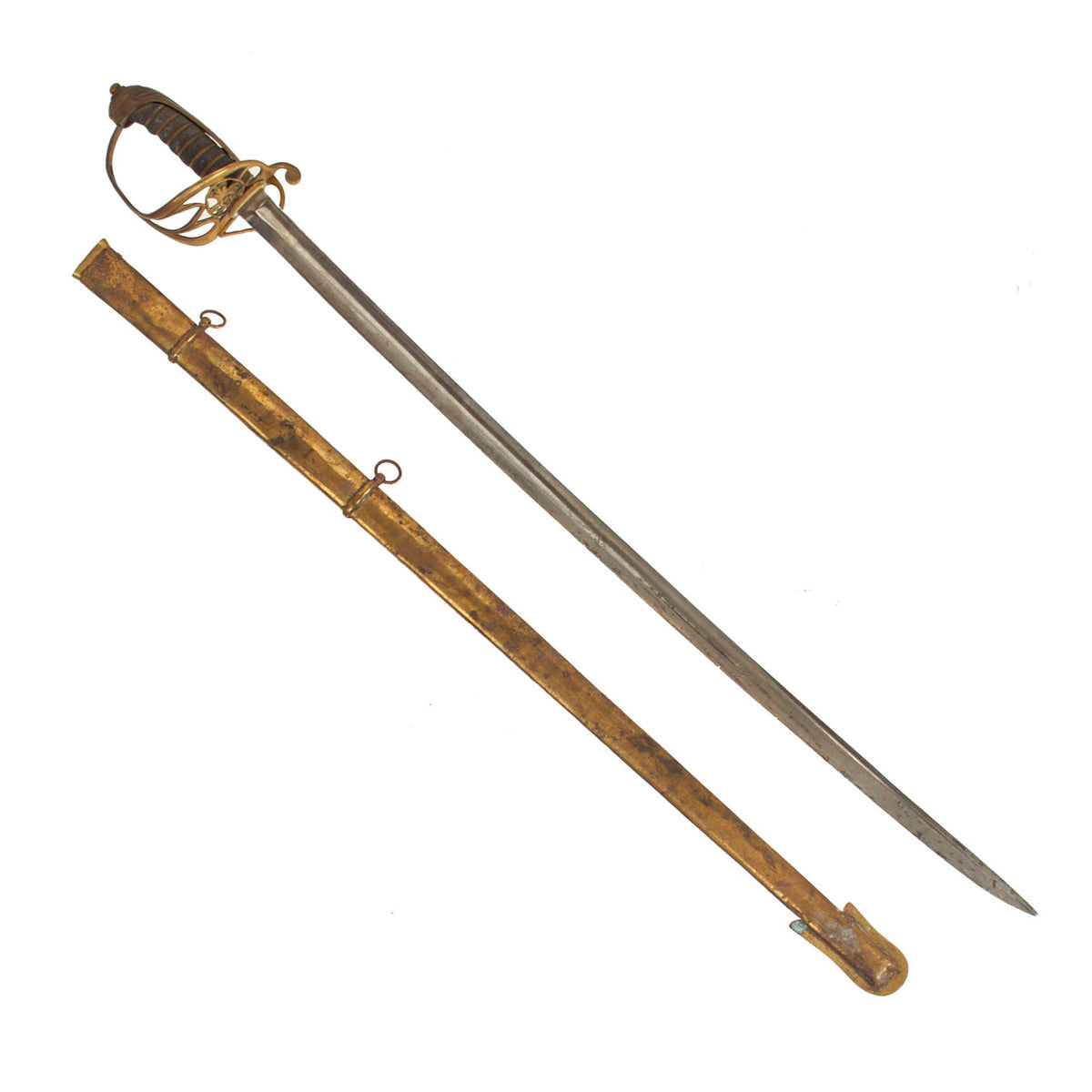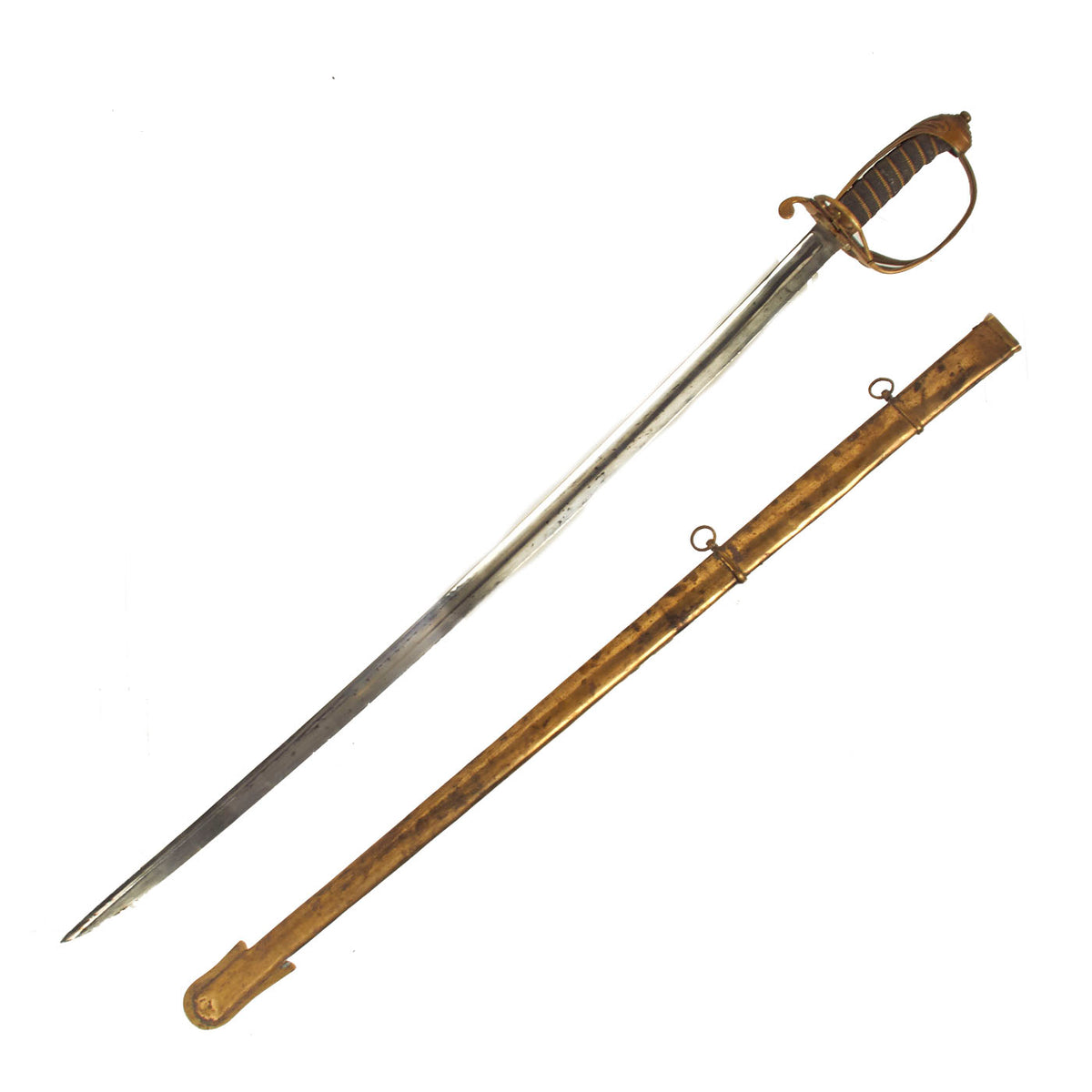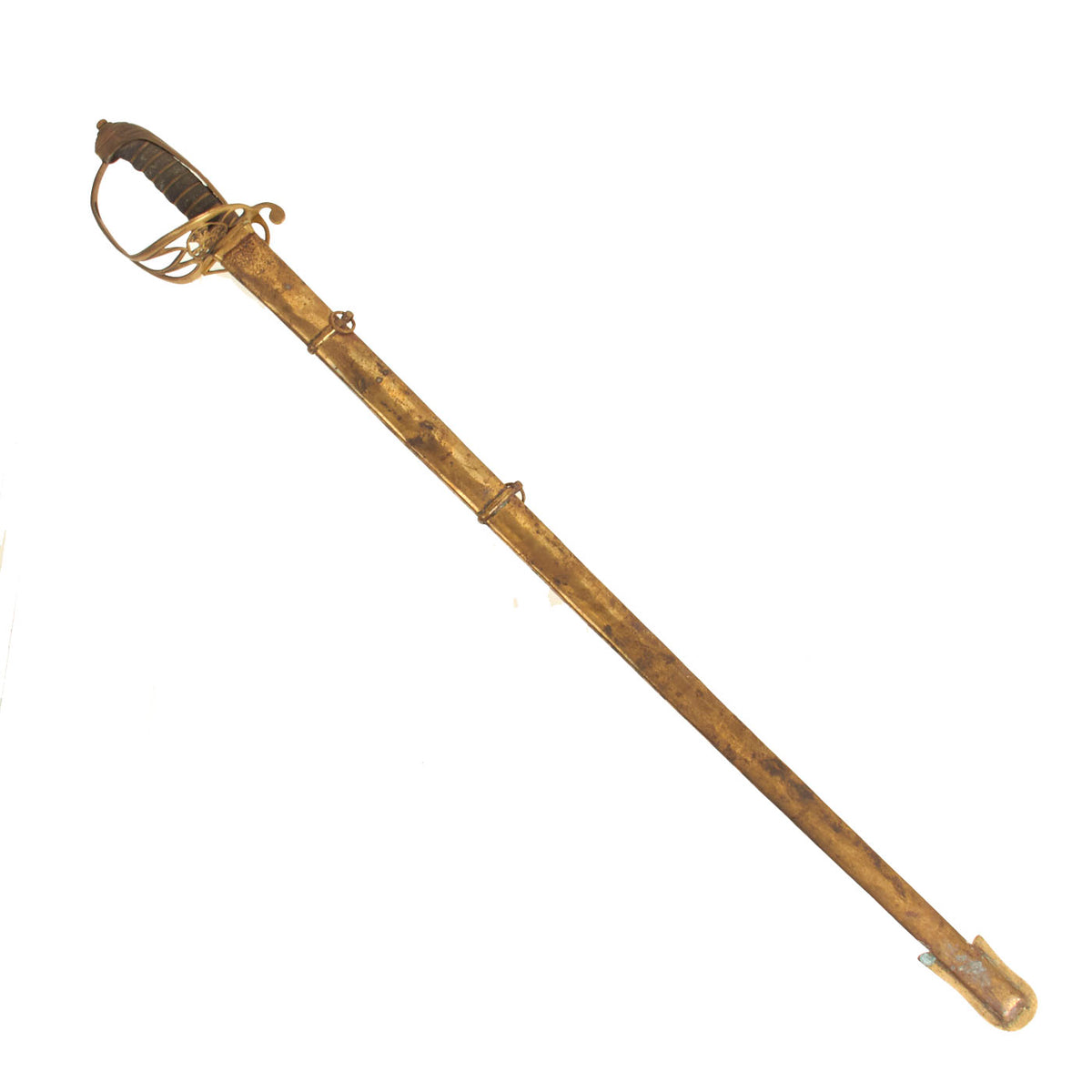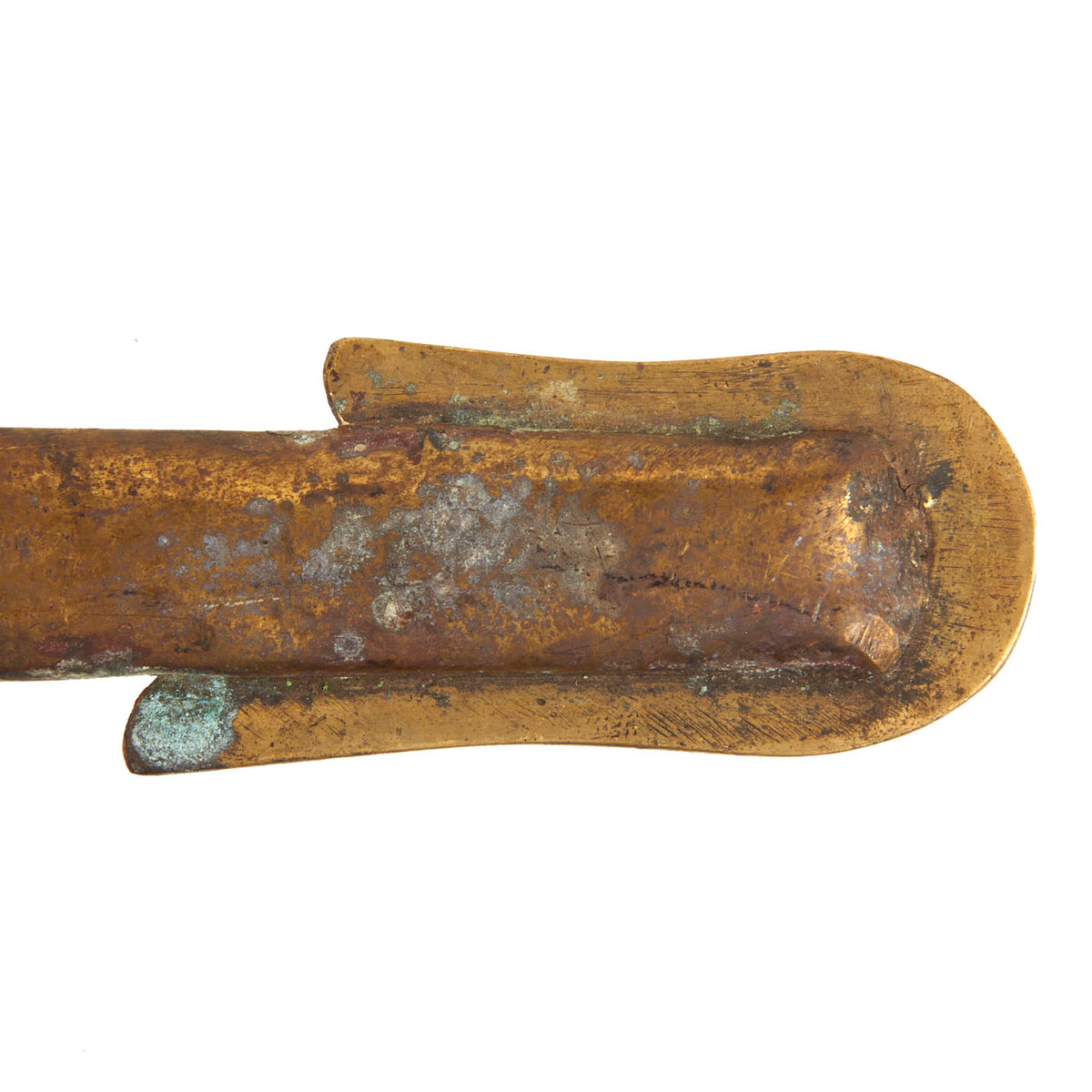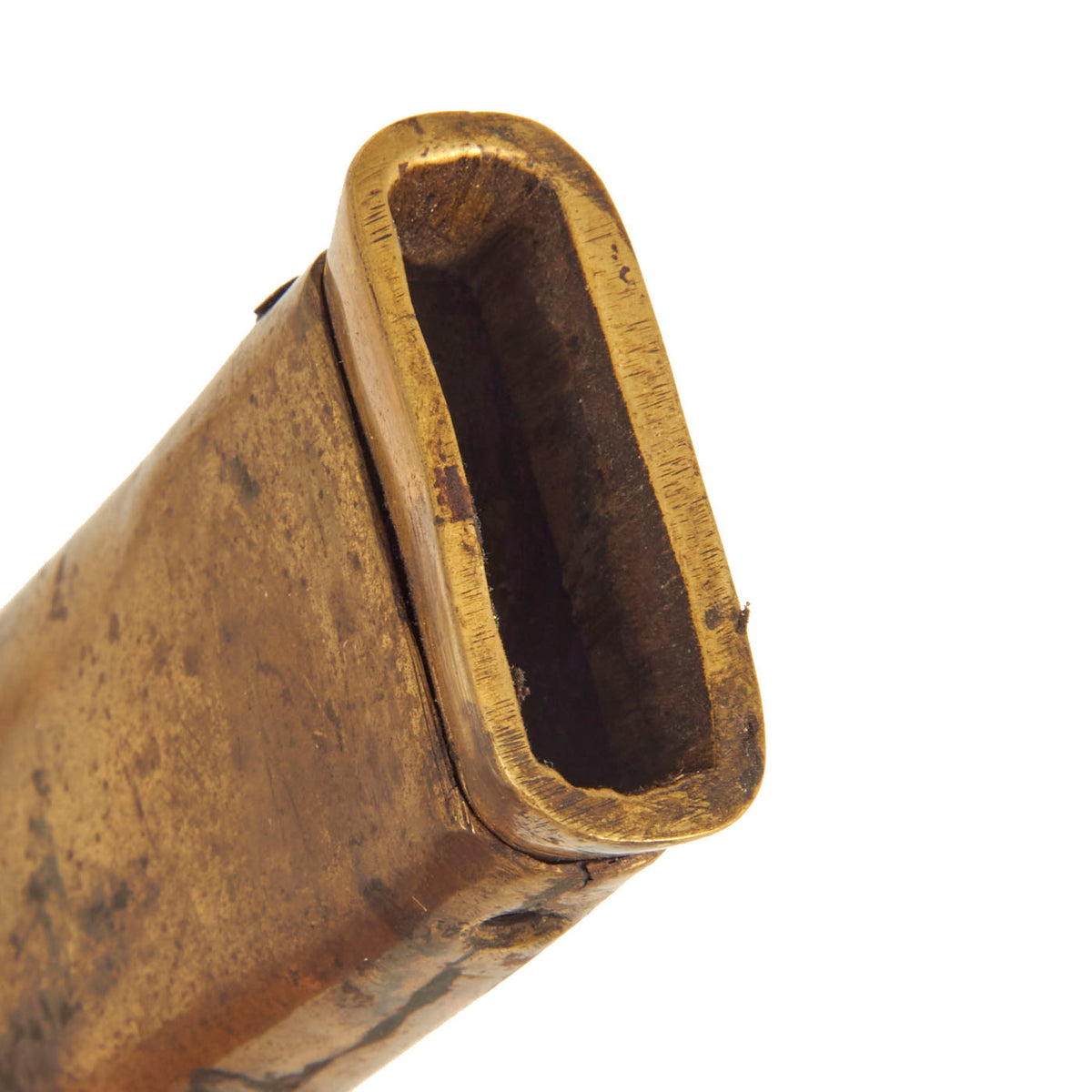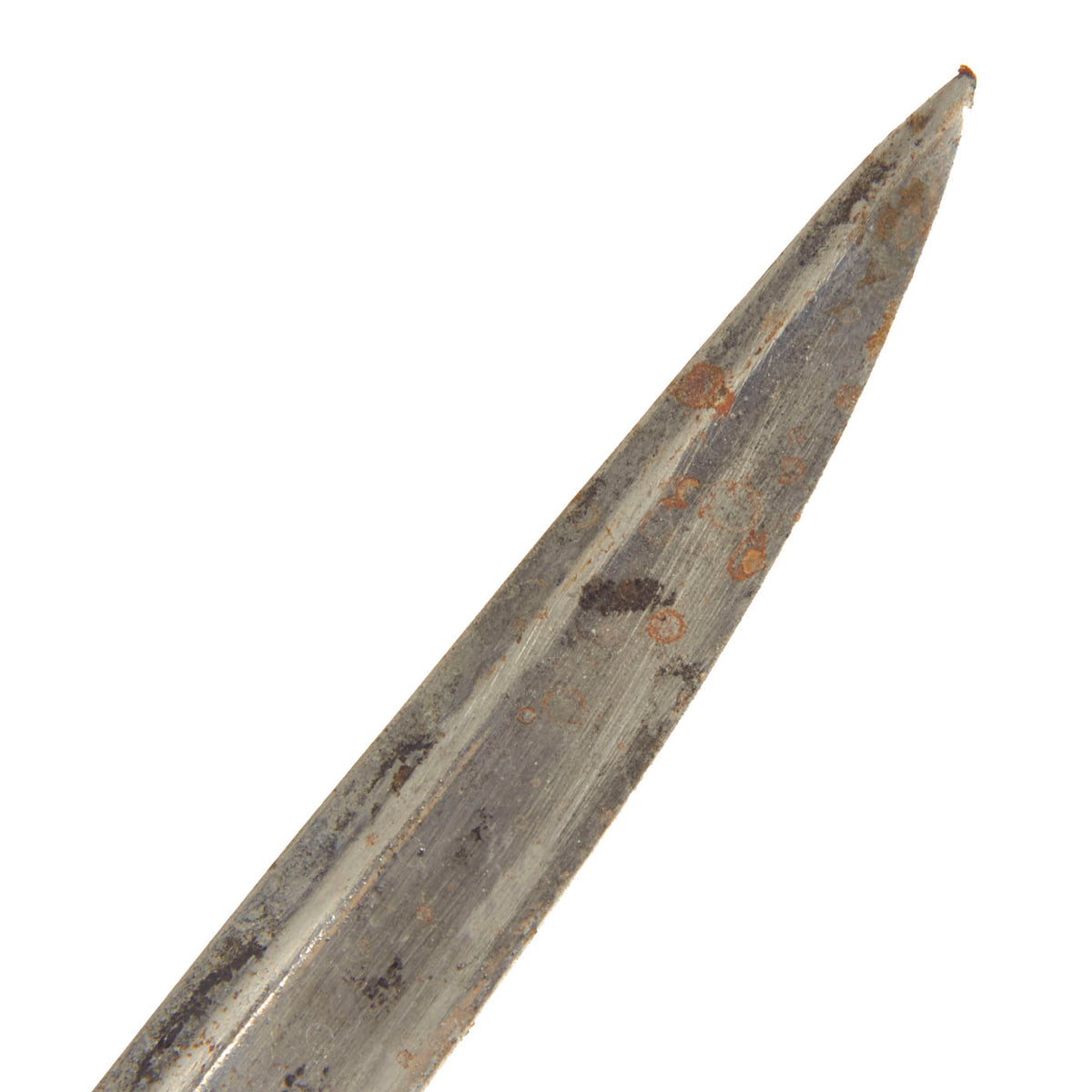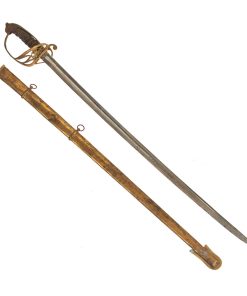Original British Victorian P-1845 Officer’s Sword with Brass Scabbard – VR Marked Original Items
$ 395,00 $ 118,50
Original Item: Only One Available. This is a very nice British Victorian Era P-1845 Officer’s Sword, complete with its original Brass Scabbard. The blade is plain steel and totally unadorned, free of any markings and stamps.
The hilt features a brass guard with a CROWN / VR Royal Cypher for Queen Victoria. Unfortunately there is cracking in the guard around the cypher. The grip is the standard wood covered with sharkskin, wrapped in twisted wire. The cross guard opposite the hand guard folds down, for more comfort when against the hip.
The blade is mostly gray with small areas of light surface rust, while the brass hilt displays areas of green verdigris, with some loss of the sharkskin covering near the pommel. There are knicks throughout the blade, whether service related or it fell victim to children pretending to be pirates, we do not know. The scabbard is in good condition with no major damage, but there is some verdigris and minor denting present.
This would make an excellent display piece for any British Victorian Era collection. Ready to display!
Specifications:
Blade Length: 32 1/8″
Blade Style: Single Edge w/ Fuller
Overall length: 38“
Scabbard Length: 33″
Gothic hilted British infantry swords (1822, 1827, 1845, 1854 and 1892 patterns)
The gothic hilted swords were a family of swords carried by officers and some NCOs of the British Army between 1822 and the present day. They were primarily infantry swords, although they were also a regulation pattern for some other officers such as surgeons and staff officers. The term “Gothic hilt” is derived from a perceived similarity between the curved bars of the guard and the arches found in Gothic architecture. They were elegant aesthetically pleasing weapons, although they were considered by some to be mediocre fighting swords. The weapon and its variants had a very long service life.
They were replaced ultimately by the 1897 pattern British infantry officer’s sword, first having the 1822 pipe-back blade replaced by the 1845 fullered blade, then the 1845 type blade replaced by a new thrusting blade in 1892 and then receiving a new steel hilt in 1895, which was then updated slightly in 1897.
1822 pattern infantry officer’s sword
The 1822 dress regulations mandated the introduction of a new sword, to replace the 1803 flank officer’s saber and the spadroon bladed 1796 line infantry officer’s sword.
The sword featured a 32.5-inch-long (830 mm), slightly curved blade of what was known as the ‘pipe-back’ design, a cross-section sometimes referred to as ‘key-hole’ shape in Victorian sources. This consisted of a flat, un-fullered, single edged blade with a nearly straight rod running along the back of the blade, with a ‘false-edge’ being formed on the back edge near to the tip, sometimes described as a ‘quill-point’. This style of blade seems to have been the innovation of the maker Prosser of Charing Cross, London, and first appeared on 1796 light cavalry style blades from around 1810–1815. This cross-section was then translated to the new narrower 1822 infantry officers’ sword. The 1822 blades generally featured acid etched decoration showing the monarch’s monogram and other devices. The pipe-backed blade is very light for its size and has a very fine edge.
The gilded brass, ‘half-basket’ hilt featured the characteristic Gothic outline, with the monarch’s monogram formed in the guard. The hilt had an ornate one piece pommel and ‘backstrap’ enclosing the end and back of the grip, held in place by a ribbed brass ring at the top of the grip and a tang nut or peened rivet at the end of the pommel. The inside section of the guard folded on a hinge towards the blade, to allow the sword to rest easily against the wearer’s side when worn. The wooden grip was covered in shark skin, known as shagreen, to give a textured surface for a secure grip, and this was wrapped with brass, copper or silver twist-wire in the recesses of the ribbed grip.
Although the pipe/rod reinforcing at the back edge of the blade was intended to add rigidity for the thrust and strength/mass for the cut, the blade was rather flexible and light at the center of percussion when made in the infantry sword size. The half basket guard gave better protection to the hand than its predecessor, the 1796 pattern, however the brass could be fragile on some examples, as illustrated by many surviving examples having damage or repairs. Later in the 19th century, it was noted in many articles on British military swords (including the lecture of John Latham of Wilkinson sword makers in 1862) that these brass guards were vulnerable to hard blows from strong cutting swords such as Indian tulwars.
1845 pattern infantry officer’s sword
In 1845, the pipe backed blade was replaced by Henry Wilkinson’s design. This was a slightly curved cut-and-thrust blade, generally of the same length of the previous pattern, however the new blade featured a single, wide fuller and a flat back, rather than the pipe back, with a symmetrical spear-point rather than the quill-point. In essence it was a curved backsword blade with an improved point. It was a slightly heavier and more robust blade than the 1822 pipe-back. This new blade was also carried over onto cavalry, engineers and artillery officer’s swords in 1845 and to naval officer’s swords in 1846.
The hilt remained essentially unchanged from the 1822 pattern, although there was a tendency for brass guards after 1845 to be made somewhat thicker and more robust than previously. The hinged guard flap, which had been standard (if not universal) from 1822, started to disappear in the 1850s, to be replaced by a solid brass guard almost universally after around 1860. This change to the hilt is sometimes referred to as the ‘1854 pattern’, but it was not technically a ‘pattern’ and the change seems to have happened at the end of the 1850s generally. Therefore, there is no actual ‘1854 pattern’ other than the Foot Guards sword (details below). Wilkinson were still making infantry officers’ swords with folding inner guards until 1859 as standard and do not seem to have switched to universally solid guards until 1860. The 1845 blade remained the same.
Direct comparison of the 1822 and 1845 blades shows that the new weapon was an improvement, being stiffer in bending and compression. It had a more robust edge, was a little heavier, had more mass in the center of percussion and the symmetrical spear-point is much better at penetrating. The blade is better therefore at cutting, thrusting and guarding. Contemporary views on the new blade were favorable and it was almost universally adopted within a year. It was also adopted and embraced by experienced combat officers ordering fighting swords who could have chosen any type of private purchase blade (for example Major Hodson and Brigadier-General Jacob both chose this blade type for their custom fighting swords, which survive in the National Army Museum and Royal Armories respectively) and it was emulated by various foreign militaries. Original sharp examples and replicas perform well in cutting tests, easily equaling other backsword and saber types.
During the period of the 1845 blades used on infantry officers’ swords, from 1845 to 1892, it has been observed that blades tended to get straighter. This is a general tendency, but not universal. One can find early examples with straighter blades and later examples with more curved blades. The curvature varied, though it is fair to say that more straight examples seem to appear from later dates. The width of the blades were usually 1+1⁄8 inches (29 mm), but some examples were only 1 inch (25 mm) wide, and again these narrower ones tend to be later in date. Again this is a general tendency and not a rule. ‘Piquet’ or dress weight examples were made with much narrower blades and correspondingly smaller hilts. The standard length of these blades was 32.5 inches (830 mm), but again there was variation, with officers basically being allowed to order whatever length best suited them. Most surviving examples are 32.5 to 34.5 inches (830 to 880 mm). Thickness or mass of blades also varied and different examples can feel quite diverse in the hand. Some are balanced to be better cutters while others make better thrusting swords.
Fast Shipping with Professional Packaging
Thanks to our longstanding association with UPS FedEx DHL, and other major international carriers, we are able to provide a range of shipping options. Our warehouse staff is expertly trained and will wrap your products according to our exact and precise specifications. Prior to shipping, your goods will be thoroughly examined and securely secured. We ship to thousands clients each day across multiple countries. This shows how we're dedicated to be the largest retailer on the internet. Warehouses and distribution centres can be located throughout Europe as well as the USA.
Note: Orders with more than one item will be assigned a processing date depending on the item.
Before shipping before shipping, we'll conduct a thorough inspection of the items you have ordered. Today, the majority of orders will be delivered within 48 hours. The delivery time will be between 3-7 days.
Returns
The stock is dynamic and we cannot completely manage it because multiple stakeholders are involved, including our factory and warehouse. So the actual stock may alter at any time. It's possible that you may not receive your order once the order has been made.
Our policy is valid for a period of 30 days. If you don't receive the product within 30 days, we are not able to issue a refund or an exchange.
You can only return an item if it is unused and in the same state as the day you received it. You must have the item in its original packaging.
Related products
Uncategorized
Uncategorized
Uncategorized
Uncategorized
Uncategorized
Uncategorized
Armored Burgonet Helmet & Polearm from Scottish Castle Leith Hall Circa 1700 Original Items
Uncategorized
Uncategorized
Uncategorized
Uncategorized
Uncategorized
Uncategorized
Uncategorized
Australian WWII Owen MK1 Machine Carbine SMG Custom Fabricated Replica with Sling Original Items
Uncategorized
Uncategorized
Uncategorized
Uncategorized
Uncategorized
